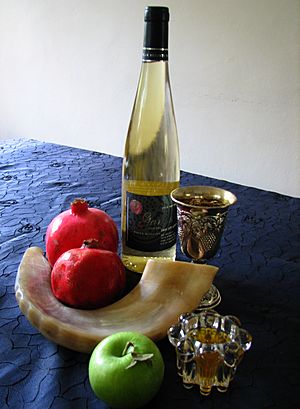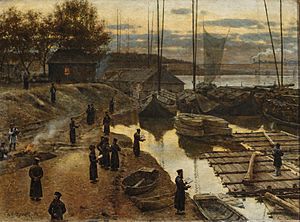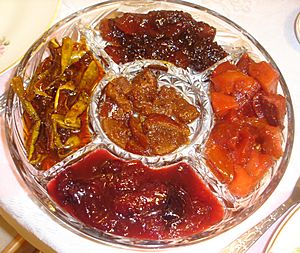Rosh Hashanah facts for kids
Rosh Hashanah is a Jewish holiday often called the "Jewish New Year." It happens on the first day of Tishrei, which is the seventh month in the Hebrew calendar. This special holiday lasts for two days.
Rosh Hashanah is the start of the High Holy Days, also known as Yamim Noraim (meaning "Days of Awe"). These are ten days set aside for thinking about your actions and making things right. They end with the holiday of Yom Kippur.
Contents
When is Rosh Hashanah?
Rosh Hashanah always takes place 163 days after the first day of Passover (Pesach).
The Jewish calendar is based on the moon's cycles. However, Rosh Hashanah is planned so it never falls on a Sunday, Wednesday, or Friday.
The Torah (Jewish holy book) describes Rosh Hashanah as a one-day celebration. But because it was hard to know exactly when the new moon appeared long ago, Jewish law changed it to a two-day holiday. This way, everyone could celebrate at the right time.
Today, most Orthodox and Conservative Judaism communities celebrate Rosh Hashanah for two days, even in Israel. Some Reform Judaism groups in North America celebrate for one day, while others observe two days to connect with Jews worldwide. Karaite Jews celebrate for only one day, as the Torah mentions only one day.
Prayers and Traditions
During Rosh Hashanah, special poems called piyyutim are added to the regular prayer services. A unique prayer book, called a mahzor, is used for Rosh Hashanah and Yom Kippur.
A very important part of the service is blowing the shofar, which is a ram's horn. The shofar is blown many times during the service. Even young children often come to hear its sound. Each time the shofar is blown, special verses from the Bible are recited.
The prayers focus on themes like God's kingship, remembering past events, and the sound of the shofar.
Symbolic Foods

Rosh Hashanah meals often include apples dipped in honey. This symbolizes a sweet new year ahead. Many communities also serve other foods with special meanings, depending on their local minhag (custom). For example, some eat the head of a fish to symbolize being "the head and not the tail."
Some families have a "Rosh Hashanah seder." During this meal, they say blessings over different symbolic dishes. These blessings often start with "Yehi ratzon", meaning "May it be Thy will." The names of these foods in Hebrew or Aramaic often sound like words related to good wishes for the new year.
Common symbolic foods include:
- Apples (with honey)
- Dates
- Pomegranates
- Black-eyed peas
- Pumpkin-filled pastries
- Leek fritters
- Beets
- A whole fish with its head
It's also common to eat stuffed vegetables.
Pomegranates are used in many traditions to symbolize being fruitful, like the many seeds inside a pomegranate. Round challah bread is typically served, representing the cycle of the year. On the second night of Rosh Hashanah, new fruits are often served.
Tashlikh Ceremony

The tashlikh ritual is performed on the afternoon of the first day of Rosh Hashanah. People go to a natural flowing water source, like a river or lake. They say prayers and symbolically "cast away" their sins into the water. Some people throw bread crumbs or small pebbles into the water to show this idea.
If the first day of Rosh Hashanah is on Shabbat, tashlikh is usually done on the second day. The tashlikh service includes prayers and verses from the Bible. It's a time for personal reflection, but it has also become a social gathering for many communities.
Greetings for the New Year
The common greeting in Hebrew for Rosh Hashanah is Shanah Tovah (Hebrew: שנה טובה). This means "[have a] good year." Sometimes people add Umetukah, saying Shanah Tovah Umetukah (Hebrew: שנה טובה ומתוקה), which means "[have a] Good and Sweet Year."
In Yiddish, people say "a gut yor" ("a good year") or "a gut gebentsht yor" ("a good blessed year").
A more formal greeting used by many religious Jews is Ketivah VaChatimah Tovah (Hebrew: כְּתִיבָה וַחֲתִימָה טוֹבָה). This means "A good inscription and sealing [in the Book of Life]." It's a wish that you will be written and sealed in God's book for a good year.
After Rosh Hashanah ends, until Yom Kippur, the greeting changes to G’mar chatimah tovah (Hebrew: גמר חתימה טובה), meaning "A good final sealing."
Images for kids
-
Traditional Rosh Hashanah foods: Apples dipped in honey, pomegranates, wine for kiddush
See also
 In Spanish: Rosh Hashaná para niños
In Spanish: Rosh Hashaná para niños




